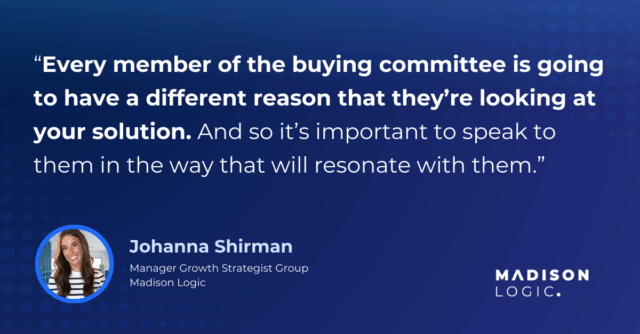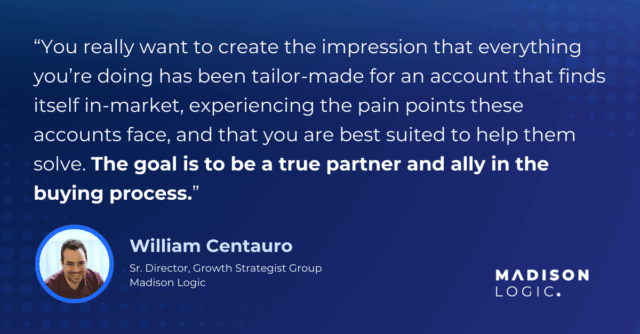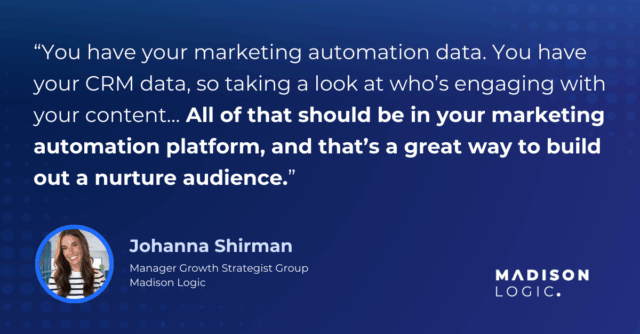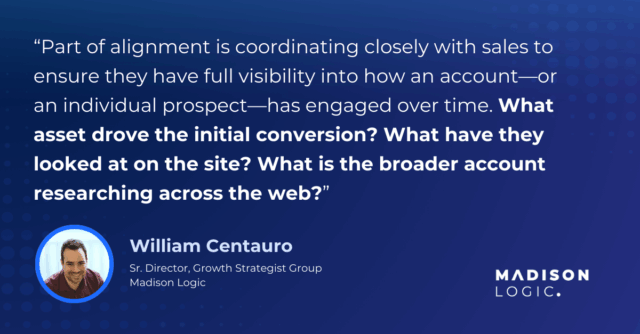
Marketing budgets were among the first to be scrutinized when the economy slowed in 2023, and that pressure hasn’t lifted. Even today, marketing teams are being asked to do more with less while navigating continued uncertainty.
At the same time, the B2B buying journey has only grown more complex. Committees are larger, sales cycles are longer, and every purchase now requires consensus across multiple stakeholders. In this environment, focusing on single leads simply isn’t enough. To maximize impact with limited resources, marketers must embrace account-based strategies that nurture the entire buying group—delivering personalized, relevant experiences that move decision-makers forward together.
In our webinar, Effective Nurture Strategies for an Economic Downturn, Madison Logic’s account-based marketing (ABM) experts shared practical ways to reach and engage accounts under constrained conditions. And while the session originally ran in 2023, the guidance is just as critical today given the ongoing economic headwinds facing B2B marketers.
Here’s what they revealed about account-based nurturing:
1. Marketers need to consider changes to buying behavior and adjust their approach based on shifts in the market
LinkedIn’s “95-5 Rule” suggests that at any given time, only 5% of target accounts are actively in-market. But because of current market conditions, that ratio has shifted dramatically—closer to 99-1. With tighter ABM budgets and fewer organizations buying, just 1% of accounts are ready to purchase, leaving the other 99% out-of-market for now.
For B2B marketers, this presents a clear challenge: while the 1% demands immediate attention, competition for that small segment has never been fiercer. As Johanna Shirman, Manager of Madison Logic’s Growth Strategist Group, explains:

The key is to guide both groups with tailored strategies:
- For the 1% in-market: Deliver solution-focused content that helps them evaluate partners. Position your brand as both a trusted knowledge source and partner capable of solving their most pressing challenges.
- For the 99% out-of-market: Invest in long-term relevance. Provide educational content that raises awareness of problems and challenges the status quo—shaping their perspective so that when budgets free up, your brand is already top of mind.
Ultimately, marketers must resist the urge to chase only immediate opportunities. By balancing short-term wins with long-term brand building, you not only compete more effectively for today’s 1%, but also ensure you’re on the Day One list tomorrow when the 99% reenter the market.
2. Effective nurturing requires attention from the entire buying committee, not just individual leads
Converting leads into opportunities involves more than talking to one person, particularly in this economic climate when buying needs are evaluated closely. Every company now operates with a buying group, and each member brings their own priorities, business focus, and purchasing timeline to the table.
Marketers can’t stop at winning over one individual, such as the direct end-user or department lead that measures how well your offering solves their problem. Your target account’s CFO cares about ROI and cost control, while the IT leader is focused on security and integration to the existing tech stack—and those priorities don’t always align.
Success depends on bringing the entire committee together and guiding them toward consensus on the best solution for their organization. The most effective way to move accounts forward is to address the distinct pain points of each stakeholder with tailored messaging that speaks directly to their perspective.
As Johanna Shirman puts it, understanding the dynamics of the buying committee is more important than ever:

Let’s look at some of the common buying group roles and the types of content that resonate with their unique priorities and values:
Budget Controller
- Focus: ROI, cost savings, risk mitigation
- Content that resonates: Business case studies showing cost reductions, ROI calculators, total cost of ownership reports
Legal/Compliance
- Focus: Integration, security, scalability, compliance
- Content that resonates: Technical whitepapers, security certifications, product demos showcasing integration ease, architecture guides
End Users
- Focus: Usability, productivity, solving day-to-day pain points
- Content that resonates: How-to guides, feature-focused videos, customer success stories in their function, product walkthroughs
Decision-Makers
- Focus: Vendor evaluation, pricing transparency, terms
- Content that resonates: Competitive comparison sheets, request for proposal (RFP) response templates, pricing guides, FAQs
Executive Sponsor
- Focus: Strategic impact, competitive advantage, long-term value
- Content that resonates: Thought leadership reports, industry benchmarks, vision-driven content, ROI-focused case studies
3. Success depends on sales and marketing alignment
Sales and marketing alignment is a core pillar of any ABM strategy. However, achieving this alignment can be tricky, especially under added pressure from economic uncertainty, tighter budgets, and increased competition.
Success starts with open communication. Regular stand-up meetings between marketing and sales are a great way to close the loop and strengthen cross-team relationships.
Both teams need to collaborate on a few key areas, as these topics impact campaign messaging, content, and outreach:
- Ideal Customer Profile (ICP): Define the characteristics of your best-fit accounts, including industry, company size, pain points, and buying behavior, so both teams are targeting the right accounts.
- Target Account List (TAL): Agree on which accounts to prioritize based on potential value and strategic fit, ensuring marketing plans are focused where sales wants to engage.
- Key Messaging: Align on the value propositions and messaging that resonate most with different stakeholders within target accounts, highlighting how your solution solves their specific challenges.
- Shared Key Performance Indicators (KPIs): Establish metrics and ABM KPIs to measure success across marketing and sales, such as account engagement, lead progression, pipeline contribution, and ultimately closed-won opportunities.
As William Centauro, Sr. Director of Madison Logic’s Growth Strategist Group explained:

It’s important to note that alignment is not a one-time effort. It’s an ongoing process where teams regularly reflect on changing market conditions, B2B buyer behavior, and business priorities. By continuously monitoring results and optimizing strategies, marketing and sales can stay aligned, make data-driven adjustments, and ensure they are driving the maximum impact across their target accounts.
4. Personalize, personalize, and then personalize some more
Since every individual on a buying committee has a unique focus, successful ABM nurturing hinges on B2B personalization. Creating an always-on ABM experience ensures your messaging resonates with each stakeholder and positions your brand as a trusted partner.
When designing personalized campaigns, keep the following in mind:
- Tailor content to specific needs and roles: Deliver messaging that speaks directly to the priorities of each persona. For example, focus on state-of-the-art patient care for a hospital director, not supply chain management strategies.
- Align content purpose with audience intent: Personalize based on where accounts are in the buying journey. For the 99% of accounts not currently in-market, provide educational content that highlights problem-solving approaches—such as adopting a new cloud solution—rather than detailed product evaluation guides. Use intent data to identify which accounts are showing early signs of interest or ABM engagement, allowing you to tailor messaging and content timing to meet their evolving needs.
- Personalize the channel: Deliver ABM content through the channels your audience prefers—content syndication, social media (LinkedIn ads), display advertising, audio advertising, connected TV (CTV), in-person events, etc.—so it reaches them where they are most engaged.
To further leverage data in the buying group era, Madison Logic’s new Buying Group Identification and Engagement Reporting tool allows you to identify key decision-makers, track engagement with the right stakeholders, and optimize campaigns with precision.
As William Centauro points out, account-based personalization isn’t just about making content available on a specific topic or problem—it’s about creating a tailored experience that resonates with each account and positions your brand as a trusted partner:

By personalizing both content and delivery channels, you not only capture attention but also build the trust, credibility, and transparency needed to move accounts toward conversion.
5. Don’t just guess; use data to inform your nurturing strategy
To cut through the noise (especially in times of economic uncertainty) quality data is essential for the best account-based marketing campaigns. It allows marketers to deliver highly relevant buying experiences while running cost-efficient nurture programs.
Data helps you understand who to target, what they care about, and how they engage—allowing you to deliver highly relevant messages, prioritize accounts, and optimize campaigns for maximum impact.
Key data sources for ABM nurture programs include:
- Firmographic & Technographic Data: Defines target accounts based on company characteristics, industry, size, and technology stack. Helps prioritize which accounts your marketing and sales teams should focus on.
- Intent Data: Reveals which accounts are actively researching solutions and may be in the 1% in-market segment. Guides content and outreach strategies to align with what buyers are actively seeking in each buying stage.
- Engagement Data: Tracks how accounts and individuals interact with your marketing assets (emails opened, links clicked, resources downloaded). Provides insights into which content resonates most and helps identify accounts showing early interest.
As Johanna Shirman noted in the webinar, it’s important to capture, organize, and connect this B2B engagement data within your marketing automation platform (MAP) and customer relationship management (CRM) platform. Doing so ensures you have a single, reliable view of account activity that can power more effective targeting and seamless collaboration with sales.

Coordinating your data inputs and updates with sales is key to maximizing the value of your data and turning insights into action. Sharing data ensures both teams have visibility into how an account, or even a specific prospect, has engaged previously. This alignment empowers sales to address last-mile objections more effectively, personalize their outreach with confidence, and ultimately move opportunities closer to closed-won.
And as our other expert, William Centauro, emphasized, data isn’t valuable on its own—it’s valuable when it feels purposeful and personalized. The goal is to use data not just to target accounts, but to show buyers that you understand their pain points and can guide them toward the right solution. He explained:

Ultimately, data helps optimize ABM nurture campaigns by showing what’s working, what to amplify, and where to pull back. It takes the guesswork out of strategies and equips both marketing and sales with the intelligence they need to succeed—even in a tough market.
Perfection Is the Enemy of Progress
Don’t overthink your ABM nurturing strategy. The most important thing is to stay top of mind—even when buyers aren’t actively in-market. Keep it simple: deliver personalized, relevant content that educates, builds trust, and keeps your brand visible. This steady presence will move accounts through the funnel and give you a clear edge over competitors who may be scaling back.
Collecting data and insights is only the starting point. The real impact comes from how you put that information into action—refining your marketing processes, strengthening alignment with sales, and guiding entire accounts through the buyer’s journey. That’s exactly what Madison Logic enables: by combining our industry-leading ML Insights intent data with multi-channel ABM activation, we help marketers optimize their strategies, make smarter use of their budgets, and deliver personalized experiences that drive measurable results.
Ready to take the next step? Jumpstart your ABM nurture program today by downloading our B2B Lead Nurturing eBook, or request a demo to see how Madison Logic can help you put these strategies into action.


